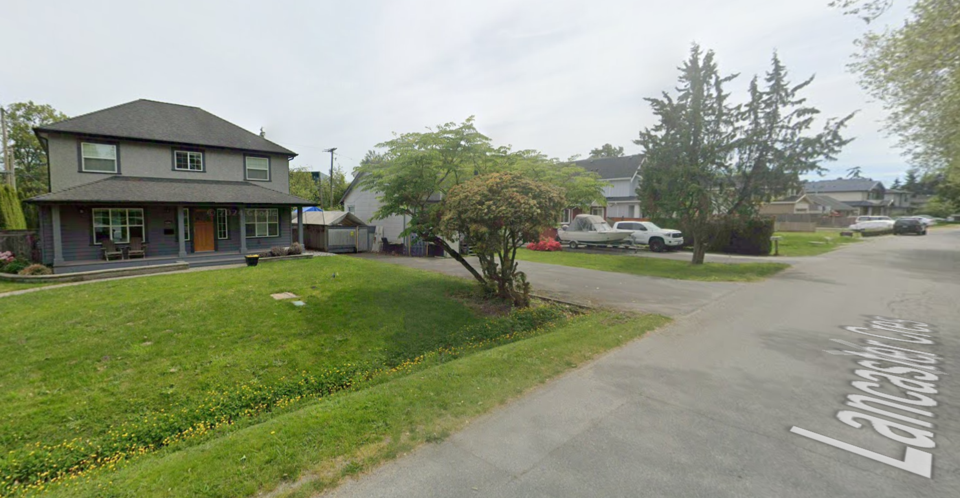Richmond has excluded 11 Burkeville properties from massive densification imposed by provincial legislation, but the province is pressuring them to allow up to eight-storey buildings on these single-family properties.
Provincial legislation requires rezoning to allow densification of single-family neighbourhoods in all municipalities, with higher densification near rapid transit.
The 11 Burkeville properties fall within 800 metres of the Aberdeen Canada Line Station – this radius around a rapid transit station in known as a transit-oriented area (TOA) and requires higher density that in other areas of Richmond.
However, in order for residents of Burkeville to use Aberdeen Station, they have to cross the Fraser River via the Moray Channel Bridge on foot, which is more like a two-kilometre, 30-minute walk – not 800 metres.
Richmond city council will consider sending a letter to the province to explain the area is not suitable as a transit-oriented area. This is on council's committee agenda on Sept. 3.
“The way I look at it is very simple. The provincial government brought in the legislation and the regulations. The province can make exceptions to that where the situation dictates,” said Richmond Mayor Malcolm Brodie.
Legislation for transit-oriented areas was passed by the provincial government in late 2023.
Following the implementation of the legislation, the Richmond city council adopted a zoning bylaw on June 24 to comply with the provincial legislation, but it excluded these 11 properties from the Aberdeen Station transit-oriented area for the reasons highlighted above.
However, a letter from the province on July 29 is requesting Richmond to amend the bylaw and include the 11 properties by Oct. 31.
Not only are they disconnected by a body of water, but residential densification close to the airport is not compatible with their activities, operations or noise regulations.
Furthermore, residential density is unlikely to increase transit usage and will lead to increased private vehicles, further disrupting the airport’s operations, according to a report from city staff.
The bylaw included the rezoning of the Spires Road area as a transit-oriented area to compensate for the exclusion of the Burkeville properties.
Transit-oriented areas were created with the purpose of encouraging residents to use public transportation and move closer to transit hubs. Single-family properties farther from transit are now rezoned to allow three to four units.
The Impacts
The Burkeville neighbourhood was built in the early 1940s for airport workers and is currently zoned as small-scale multi-unit housing– if added to the Aberdeen transit-oriented area, they could be permitted to achieve a density of 3.0 floor area ratio and build up to eight storeys high, which Brodie says could be problematic.
“I think it's fair to say that if it was a greenfield site now, you would never allow Burkeville to be built because it is so close to the airport operations,” he said. “The airport is very concerned with how close the buildings are to the airliners. You want to build up to eight floors in an area which borders the airport?”
The densification of the neighbourhood could also have an impact on property prices and could require additional infrastructure to be built to accommodate for the influx.
This can be applied to every neighbourhood in Richmond, said the mayor – the infrastructure is not meant for these very large increases.
Parking will also be affected, as having no off-street requirements in residential areas will increase the number of vehicles parked on the street, increasing congestion.
Brodie has been critical of the approach of the provincial government to densify any single-family neighbourhood without public consultation, without mandating parking or upgrading the area’s infrastructure and services.
“We think that the one-size-fits-all approach is very problematic,” he said. “We have agreed to densify our city centre and along the arterial roads for at least 20-25 years, and we've been met with great success – it's a gentle densification.”
With discussion pending at the general purposes committee meeting on Sept. 3, staff are recommending council not to amend the bylaw, but rather to send letters to provincial staff alongside YVR, advising the area is not suitable to be included in the transit-oriented area and requesting a change in the boundary of Aberdeen Station.
There will also be efforts to speak with the minister of housing and the minister of transportation about the situation and engage in active discussions with the province.
Lastly, this option will also include an amendment to the city’s Official Community Plan (OCP), indicating Burkeville is not suitable for denser forms of residential development.
Got an opinion on this story or any others in Richmond? Send us a letter or email your thoughts or story tips to [email protected]. To stay updated on Richmond news, sign up for our daily headline newsletter. Words missing in article? Your adblocker might be preventing hyperlinked text from appearing.



